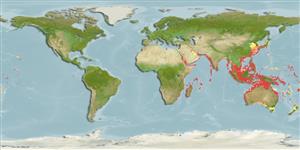Common names from other countries
Environment: milieu / climate zone / depth range / distribution range
Οικολογία
βενθικό(ς); Υφάλμυρο; εύρος βάθους 0 - 100 m (Ref. 275). Tropical; 51°N - 48°S, 22°E - 155°W (Ref. 106950)
Indo-Pacific: from Japan to Australia and New Zealand coasts, from Hawaii to the East African coast, north to Red Sea and south to Madagascar. Introduced in the Mediterranean Sea.
Length at first maturity / Μέγεθος / Βάρος / Age
Maturity: Lm ? range ? - ? cm Max length : 40.1 cm ML αρσενικό/απροσδιόριστο; (Ref. 121859); μεγ. δημοσιευμένο βάρος: 1.80 g (Ref. 275)
Also caught by set nets and spears and jigs.
Life cycle and mating behavior
Γεννητική Ωρίμανση | Αναπαραγωγή | Γεννοβολία | Αβγά | Γονιμότητα | Προνύμφες
Members of the class Cephalopoda are gonochoric. Male and female adults usually die shortly after spawning and brooding, respectively. Mating behavior: Males perform various displays to attract potential females for copulation. During copulation, male grasp the female and inserts the hectocotylus into the female's mantle cavity where fertilization usually occurs. Life cycle: Embryos hatch into planktonic stage and live for some time before they grow larger and take up a benthic existence as adults.
Roper, C.F.E., M.J. Sweeney and C.E. Nauen. 1984. (Ref. 275)
IUCN Red List Status (Ref. 130435: Version 2024-1)
CITES status (Ref. 108899)
Not Evaluated
Not Evaluated
Human uses
αλιεία: Εμπορικό(ά)
FAO - αλιεία: landings | FishSource | Η θάλασσα γύρω μας
Εργαλεία
Διαδικτυακές πηγές
Estimates based on models
Preferred temperature
(Ref.
115969): 23 - 29.1, mean 28 (based on 2210 cells).
Ελαστικότητα
Υψηλό, ελάχιστος χρόνος για διπλασιασμό πληθυσμού < 15 μήνες (K=0.73-1.25).
Vulnerability
Low vulnerability (19 of 100).
